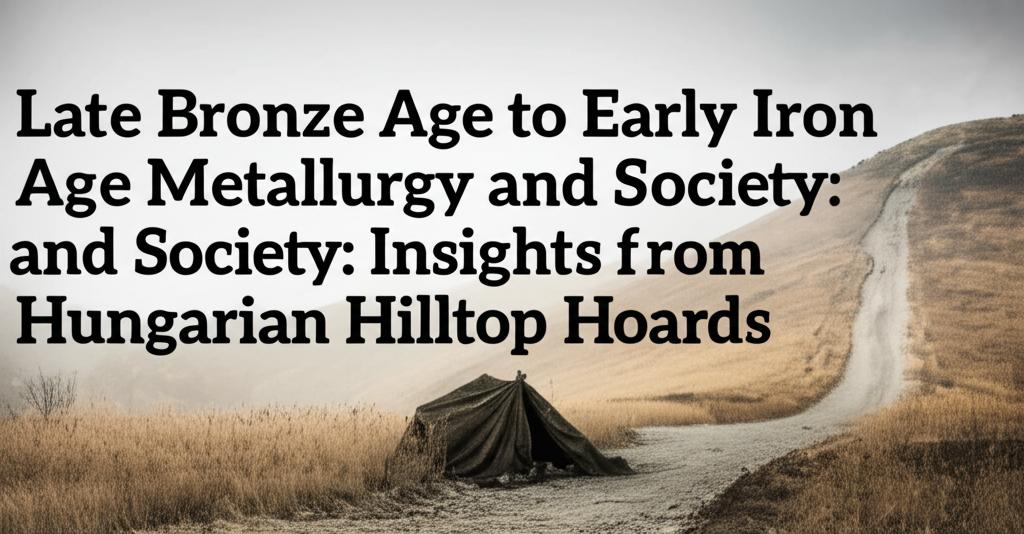Recent archaeological investigations on Somló Hill in western Hungary are providing significant new insights into the societies and metallurgical practices of the Late Bronze Age (roughly 1450-800 BCE) and Early Iron Age (roughly 800-450 BCE). Discoveries made between 2023 and early 2025, including over 900 metal artifacts, are helping to illuminate a period of transition that was previously not well understood in this region.
Hilltop Settlements as Centers of Power and Ritual:The volcanic butte of Somló Hill, rising prominently over the surrounding landscape, appears to have been a significant center for ancient communities. Evidence suggests continuous occupation from the Late Bronze Age into the Early Iron Age, challenging previous assumptions about settlement patterns during this transitional phase. The quantity and quality of the artifacts, which include jewelry, tools, military decorations, weapons, and items associated with bronze working, suggest that Somló Hill may have been a seat of power for an elite class, possibly warrior leaders, within clan-based or tribal societies.
Hoarding Practices and Metallurgical Insights:A key aspect of the recent discoveries is the unearthing of six distinct hoards – five from the Late Bronze Age and one from the Early Iron Age. These hoards offer an unparalleled opportunity to study ancient depositional practices. The meticulous excavation and documentation of these hoards, including the use of photogrammetry and video recording, are crucial for understanding how these valuable items were arranged and buried.
Interestingly, two of the hoards (Hoard III and Hoard V) were found buried within ceramic vessels. This is a significant find, as it's the first confirmed evidence of metal objects being stored this way in ceramic pots during this period in western Hungary. Hoard V, in particular, is considered highly important as it provides the first evidence of local metal deposition customs during the Late Bronze Age to Early Iron Age transition. This hoard contained not only metalwork but also amber beads (suggesting long-distance trade), pig and boar tusks, and even fragments of textiles and leather, highlighting the ritual complexity of these deposits.
The presence of bronze lumps, droplets, casting jets, and fragmented ingots strongly indicates that bronze-working workshops were active on Somló Hill, suggesting local production of metal objects. The discovery of an Alpine-style spearhead in Hoard I is also of note.
Understanding the Transition:The finds from Somló Hill are particularly valuable for understanding the shift from the Late Bronze Age to the Early Iron Age, a period around the late ninth century BCE. The continuous occupation and the nature of the hoards are providing crucial data for a time that has been relatively obscure in this part of Europe. Radiocarbon dating of organic materials found within the hoards is expected to further refine the timeline of the site's occupation and the hoarding traditions.
The Hallstatt culture, a farming society known for advancing metalwork in Central and Western Europe during the Bronze and Iron Ages, seems to have had a significant presence at Somló. The discoveries are poised to enhance understanding of the timeline and geographical distribution of this influential culture.
Advanced Archaeological Techniques:The success of these recent investigations can be attributed in part to the use of advanced survey techniques. These include metal-detector surveys, field-walking, magnetic prospection, and airborne laser scanning (LiDAR). LiDAR, in particular, has been instrumental in creating detailed digital terrain models, revealing previously unidentified features such as possible prehistoric pathways and terraces, despite centuries of viticulture altering the landscape. Computed tomography (CT) scanning has also been employed to analyze the internal arrangement of objects within the excavated ceramic vessels.
Ongoing Research and Future Implications:While these discoveries have already yielded a wealth of information, research is ongoing. The identity of the people who inhabited Somló Hill during this period remains a subject of investigation, as western Hungary lacks clear cultural or ethnic markers from this time. However, the deliberate organization and layering of objects within the hoards suggest sophisticated ritual and symbolic behavior.
The Somló Hill finds are rewriting aspects of the regional Bronze Age chronology. Hoards from this specific period (Hallstatt B1 and B2, approximately 1080-900 BCE) are rare in Hungary's Transdanubia region, especially those with secure archaeological contexts. The evidence of uninterrupted occupation through the Bronze Age-Iron Age transition is a key finding that challenges previous narratives.
In summary, the ongoing exploration of Hungarian hilltop hoards, particularly at Somló Hill, is providing invaluable data on the metallurgical practices, social structures, ritual behaviors, and settlement patterns during the critical transition from the Late Bronze Age to the Early Iron Age. These findings are significantly advancing our understanding of this dynamic period in European prehistory.

